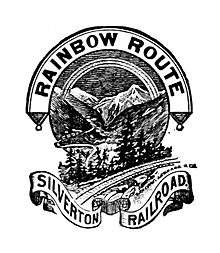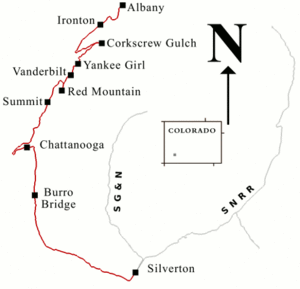Silverton Railroad
| Silverton Railroad | |||
|---|---|---|---|
 | |||
| Overview | |||
| Other name(s) | The Rainbow Route | ||
| Status | Defunct | ||
| Locale | Colorado | ||
| Termini |
Silverton, Colorado Albany, Colorado | ||
| Operation | |||
| Opened | 28 January 1888 | ||
| Closed | 1926 | ||
| Owner | Otto Mears | ||
| Character | 3-foot narrow-gauge mountain mining railroad | ||
| Technical | |||
| Line length | 21.5 mi (34.6 km) | ||
| Track gauge | 3 ft (914 mm) | ||
| Minimum radius | 30-degree (194-foot radius) | ||
| Highest elevation | 11,111 ft (3,387 m) | ||
| |||
The Silverton Railroad, now defunct, was an American 3 ft (914 mm) narrow gauge railroad constructed between Silverton, Colorado and mining districts near Red Mountain Pass, Colorado.
The Silverton Railroad is remembered for the innovative solutions to difficult engineering problems presented by the steep, mountainous terrain which were devised by the railroad's chief locating engineer, Charles Wingate Gibbs – the Chattanooga Loop, the depot in a wye at Red Mountain, and a covered turntable on the main track at Corkscrew Gulch – and for the unusual and expensive annual passes presented by the owner, Otto Mears.[1]
- Chattanooga Loop – Gibbs achieved a 550-foot rise in the line over a quarter-mile straight-line distance by a detour from Mineral Creek up Mill Creek gulch, with in a 30-degree (194-foot radius) curve looping 200 degrees at the end, and returning to Mineral Creeek, all on a 5-percent grade.[1]
- Red Mountain Wye – extremely limited level space and hard rock at Red Mountain town, precluding a balloon loop or turntable for turning trains, led Gibbs to plan a wye with short arms able to accommodate only a locomotive and two cars, and to place the station house on the only remaining flat area, in the center of the wye.[1]
- Corkscrew Gulch Turntable – to solve the operational difficulties presented by the switchback at Corkscrew Gulch, Gibbs placed a turntable on the main track at the junction of the lower and upper arms of the switchback, allowing the locomotive to work downgrade of ore cars for safety and efficiency. The 50-foot turntable was big enough only for the locomotive, and the cars were fed through by gravity in both directions. The turntable was covered with a snowshed to allow operations as deep into winter as possible.[1]
- Railroad Passes of Otto Mears – Railroads until 1906 commonly issued free printed paper or card travel passes to such people as employees, their families, shippers, clergymen, politicians, judges and others whose influence was sought in the railroads' favor. Mears wanted to make the passes issued by his railroads special. The passes for the Silverton Railroad in 1888 were printed on buckskin, in 1889 were of stamped silver, and the 1890 passes were watch fobs. None were issued in 1891, but the 1892 passes good on both Mear's Silverton and Rio Grande Southern Railroads were of silver filigree, and three were made of gold.[2]
The Silverton Railroad was the first of several railroad projects by Otto Mears, the famed "Pathfinder of the San Juans". Construction of the line began in 1887 and reached Burro Bridge by early November, when work was halted for the winter. The route followed a survey made by the Denver & Rio Grande up Mineral Creek to climb Red Mountain Pass to reach the incredibly rich mining district around Red Mountain Town. Construction resumed and service began the following year, and the line reached Ironton in November.[3] The line reached its greatest extent in September 1889 with the completion from Ironton of a spur to a mill at Albany.[1]
In 1889, surveying and grading was begun on a branch up the upper Animas River to Eureka. This project became the beginning on the Silverton Northern Railroad.[1]
A line was proposed to connect Ironton with Ouray in 1892 which would have been electric-powered and used a rack-and-pinion system to overcome the steep grades of 7%, but the Silver Crash of 1893 prevented further construction. The railroad struggled through market and weather difficulties, was ordered into receivership in 1898 and was sold under foreclosure in 1904.[1] It was reorganized as the Silverton Railroad Company,[4] but was never very successful, and was finally dismantled in 1926.
Notes
- 1 2 3 4 5 6 7 Sloan, Robert E., and Carl A. Skowronski (1975). The Rainbow Route: An Illustrated History. Denver: Sundance Limited. pp. 53–126. ISBN 0913582123.
- ↑ Strong, William K. (1988). The Remarkable Railroad Passes of Otto Mears. Silverton, Colorado: San Juan County Book Company. p. 4. ISBN 0-9608000-6-9.
- ↑ Wilkins, Tivis E. (Tiv) (1974). Colorado Railroads: Chronological Development. Boulder, Colorado: Pruett Publishing Company. pp. 65, 72, 75. ISBN 0-87108-073-7.
- ↑ Stone, Wilbur Fiske (1918). History of Colorado. S.J. Clarke. p. 381. Retrieved 20 April 2009.
References
- Hilton, George W. (1990). American Narrow Gauge Railroads. Stanford, California: Stanford University Press. ISBN 0-8047-2369-9.
| Wikimedia Commons has media related to Rail transport in Colorado. |
